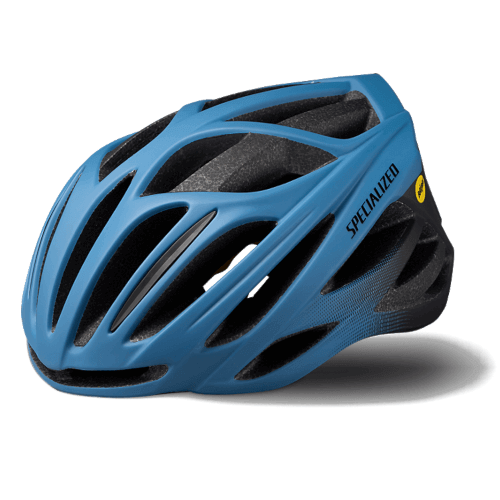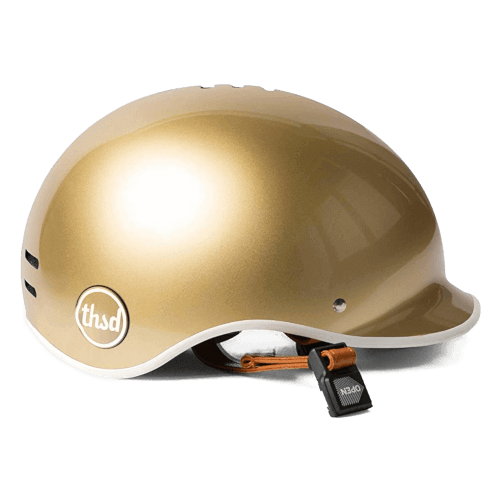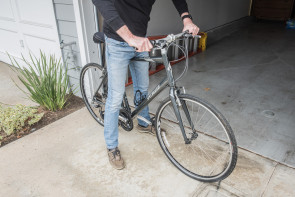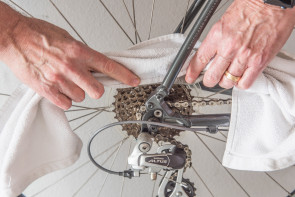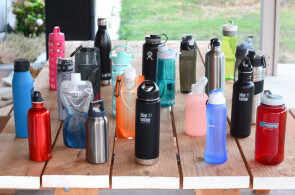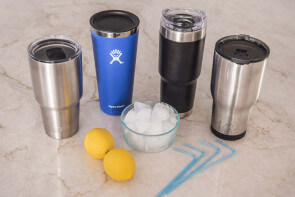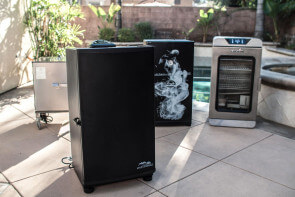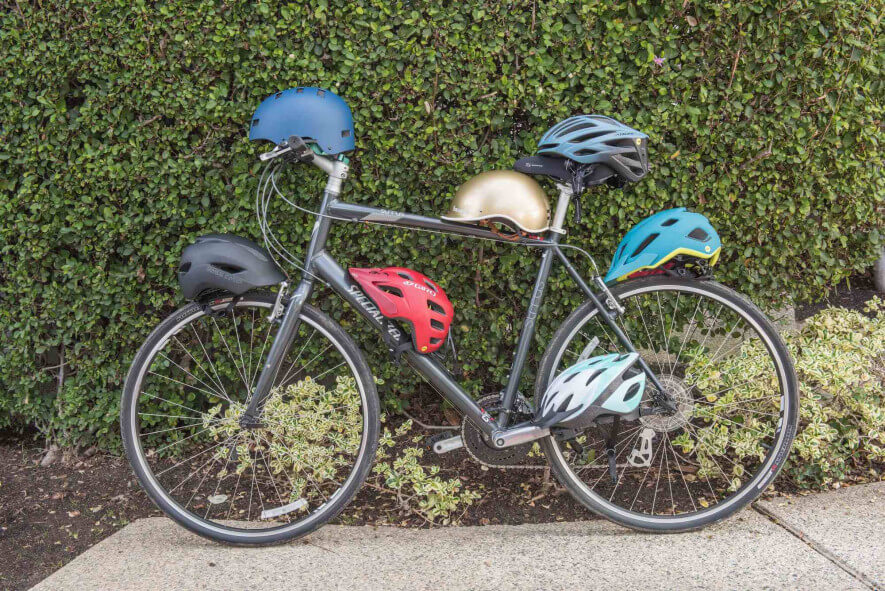
The Best Bike Helmets
We rode over hill and dale, in good weather and bad, to test seven of the best bike helmets under $100. We’ve chosen the lightweight and well-ventilated Specialized – Echelon II as the best road helmet with the latest MIPS technology, unique chin straps and ponytail-ready Hairport fit system. The stylish Thousand – Anti-Theft Helmet is our choice for the best commuter helmet because of its innovative magnetic buckle, magnetic anti-theft portal and dial-adjustment fit system, an unusual feature for a commuter helmet.
We rode over hill and dale, in good weather and bad, to test seven of the best bike helmets under $100. We’ve chosen the lightweight and well-ventilated Specialized – Echelon II as the best road helmet with the latest MIPS technology, unique chin straps and ponytail-ready Hairport fit system. The stylish Thousand – Anti-Theft Helmet is our choice for the best commuter helmet because of its innovative magnetic buckle, magnetic anti-theft portal and dial-adjustment fit system, an unusual feature for a commuter helmet.
Table of contents
- How we selected helmets to test
- Compare the best bike helmets
- Types of bike helmets
- How we tested
- Important features to consider
- Best road helmet: Specialized – Echelon II
- Best commuter helmet: Thousand – Anti-Theft
- Other helmets we tested
- The bottom line
How we selected helmets to test
We’ve reviewed the best bike pump, the best messenger bag and the best bike rack, so we turned our critical eye to look at the latest technology and advancements in bike helmets.
Although wearing a helmet is mandatory in only 21 states, the articles we read in Cycling Weekly, Bicycling.com and Popular Mechanics re-emphasized that a bike helmet could save your life and prevent brain injury in the event of an accident. We also consulted Reddit threads in r/cycling and r/bikecommuting for road helmet and commuter helmet recommendations.
Once we knew what cyclists look for in a helmet, we went through Amazon’s many offerings and selected those with the highest ratings. You could easily spend $300 or more on the latest model, but we focused on the most popular designs that sell for $100 and less. On Amazon, you could certainly buy a helmet for about $25, but these have few safety features and, as we discovered, not all are certified by the U.S. Consumer Protection Standard Committee (CPSC) and shouldn’t even be sold in the U.S.
Since our tester doesn’t live in a mountainous area, we decided not to test mountain helmets and only test road helmets and commuter helmets. Though the latest technology substantially increases the price of a helmet, safety is the primary reason for purchasing one. We chose three helmets that were more expensive but still affordable, three commuter helmets — which do not have the same safety technology — and the Schwinn – Thrasher, the most popular and highest-rated road helmet on Amazon.
Compare the best bike helmets

| Product | Price | Type of Helmet | Fit | MIPS Technology | Comfort |
|---|---|---|---|---|---|
| Specialized - Echelon II | $$$ | Road | ★★★★★ | Yes | ★★★★★ |
| Thousand - Anti-Theft | $$$ | Commmuter | ★★★★★ | No | ★★★★★ |
| Bontrager - Quantum | $$$$ | Road | ★★★★★ | Yes | ★★★★ |
| Giro - Fixture | $$$ | Road | ★★★★ | Yes | ★★★ |
| Retrospec - CM1 | $$ | Commuter | ★★★ | No | ★★★ |
| Schwinn - Thrasher | $ | Road | ★★ | No | ★★★ |
| Base Camp | $$ | Commuter | ★★ | No | ★★ |
Types of bike helmets
There are three basic types of bike helmets for different riding disciplines. Certain sports, such as BMX and downhill racing, have alterations, but generally, the shape and design fall into one or two of the following categories.
Road helmets
As most accidents happen to the front of the rider, a road bike helmet has the bulk of its protection on the front and sides. They have a slightly elongated shape with multiple vents to keep the head cool while riding. Road bike helmets are also designed to be lightweight. Road bikers don’t typically use visors since they wear eye protection for glare and wind. But most of the road bike helmets we researched, and all of the road bike helmets we tested, had a visor that could be removed.
Mountain bike helmets
In mountain biking, a crash can happen in any direction. A mountain bike helmet is also elongated, but its protection is primarily on the sides and back. It also has a visor to shield the rider’s eyes from glare, rain and low-hanging tree branches. Some mountain bike helmets have a full-face extension for protecting the mouth and chin.
Commuter helmets
A commuter helmet isn’t designed for speed racing or long rides. As its name implies, a commuter helmet is for riding short distances to and from work. They’re slightly heavier than other helmets and shaped like a mushroom cap. A commuter helmet has fewer vents than road and mountain helmets to protect against rain. Some commuter helmets have a light built into the back for nighttime riding.
How we tested
We began our tests by first adjusting each helmet to fit on our rider’s head. As we noted earlier, it’s imperative that the steps to fitting a bicycle helmet be followed precisely before the first bike ride. As required by federal law, a helmet manufacturer must include detailed instructions and safety warnings.
The helmet needed to first be properly fit on our rider’s head so it sat slightly over the brow. Chin straps were loosened or tightened so the V of the strap lay flat just beneath each earlobe. The chin strap was then buckled and excess strap was slid through its O-ring (a standard feature in all helmets we tested). If the helmet had a dial-adjustment system, the back strap was tightened so the helmet fit snugly and didn’t move when the rider shook his head.
Naturally, the best way to test a helmet is by taking it for a spin on a bike. But always make sure that your bike’s tires are inflated. So when you pull your bike down off your bike rack, check your tires’ air pressure first and inflate them with our top pick for bike pumps.
For each helmet, our rider rode two to three miles on busy thoroughfares that were a mix of flat streets and hills. Weather conditions were mostly sunny with high glare and, some days, gusty winds. After each ride, he noted:
- Whether the helmet had remained in place
- If the chin straps had shifted
- If the helmet was comfortable to wear
- Whether the helmet had enough ventilation to keep his head cool
Although he had a couple of near misses, for obvious reasons, he did not simulate a crash, so we did not test how well each helmet performed upon impact.
Important features to consider
MIPS technology
MIPS (Multi-directional Impact Protection System) is a technology that’s recently been implemented in bicycle helmets. It was developed in the late 1990s by a Swedish neurosurgeon and research scientists to reduce the brain’s rotational forces caused by impacts at various levels to the head.
Two forces — linear and rotational — are related to the majority of brain injuries. A linear force happens when your head hits something straight-on. A typical helmet has liners that absorb the impact almost like a second skull.
A rotational force occurs when your head is struck at an angle — for example, falling off or being thrown from your bike. This impact can cause the brain to twist in the skull and sustain injury. MIPS technology is a liner inside the helmet that rotates upon impact and substantially reduces rotational forces and direct trauma to the brain.
Although MIPS is the new buzzword for selling bicycle helmets at elevated prices, there is substantial controversy as to whether it actually makes helmets safer. Manufacturers offer impressive charts as to what happens to a bicycle-rider’s brain upon impact when he or she is not wearing a MIPS helmet. But to avoid litigation, they only claim that a MIPS helmet is 10% safer than a non-MIPS helmet.
U.S. CPSC standards
All bicycle helmets manufactured after 1999 must comply with the U.S. Consumer Product Safety Commission (CPSC) standard for providing protection against skull fracture and brain damage. Helmets are tested to ensure:
- They don’t block the rider’s peripheral vision
- They don’t come off when a rider falls
- Buckles and straps are secure and don’t detach or stretch
- The helmet significantly reduces the force to a rider’s head upon impact
When purchasing a bicycle helmet, always look for a label noting that it has passed the CPSC standards for safety. The label, however, must also have specific language regarding the manufacturer (name, address, telephone number, etc.) and several warnings about proper fitting and use.
Consumer Reports recently found 13 bicycle helmets for sale on Amazon, Sears and Aliexpress that did not have the CPSC label, which means it is illegal for these helmets to be sold in the U.S. More disconcertingly, Consumer Reports also found helmets that had phony CPSC labels.
The bottom line: Look for the CPSC label and the required information and warnings. If the helmet you purchased does not have the required labeling, report it to the CPSC.
Fit
A helmet that doesn’t fit properly will compromise its safety. Many helmets are available in small, medium and large, but depending on where and how the helmet is manufactured, there is often no set sizing standard. It’s important to know that a medium for one brand might be slightly smaller or larger than that of another brand. Also how the helmet is shaped will affect how it fits. For example, Italian helmets tend to be narrower, while American helmets are more rounded.
The only way to ensure that a helmet will fit is by using a tape measure to measure the circumference of your head in inches and centimeters, which are both used by helmet manufacturers. The helmet should fit snugly without the aid of chin straps.
Some helmets only come as one-size-fits-all, and of those we tested, they were the most ill-fitting. If you plan to purchase this type of helmet, then you need correct measurements of your head and the helmet, and you should always try it on first before purchasing.
Retention system
A bicycle helmet’s retention system includes the chin and side strap and sometimes a tightening mechanism that’s located at the back of the helmet. The side straps should fit over your ears in a V-shape so the strap adjuster (usually a buckle) sits just beneath your earlobes. The chin straps should sit flat on your cheeks and jawline and then secure tightly with a quick-release buckle.
The tightening mechanism is an adjustable dial that loosens and tightens the helmet’s lining at the back of the head. The adjustment dial is a standard feature in almost all road bike helmets; it’s not common, however, in commuter helmets, which rely more on foam padding that isn’t as efficient in properly fitting the helmet to your head.
Best road helmet: Specialized – Echelon II
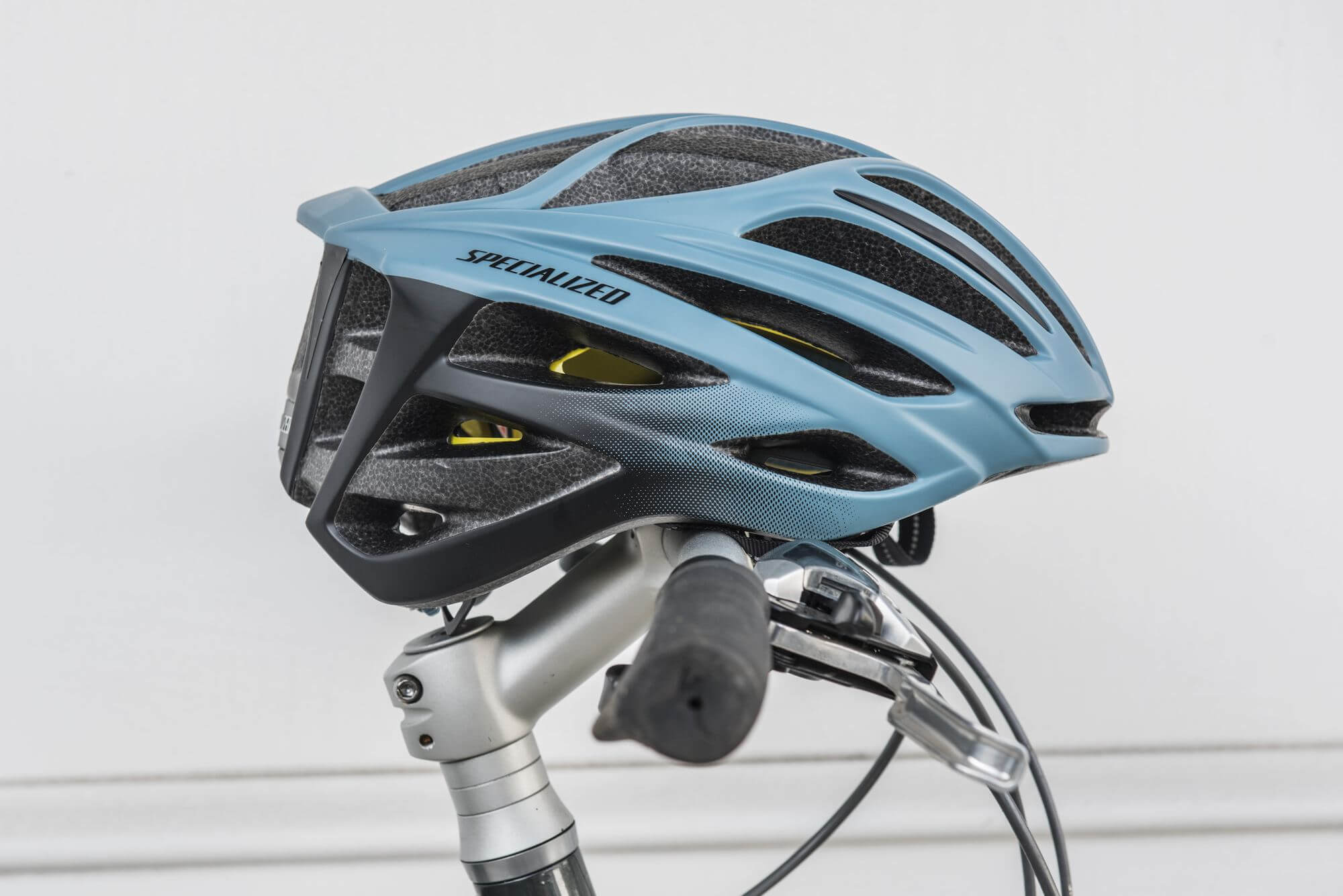
The Specialized – Echelon II is a lightweight, streamlined and generously ventilated road helmet with sturdy and easily adjustable chin straps that lay flat against cheeks and jawline. It comes equipped with the Hairport dial fit system, which can accommodate a ponytail through the back of the helmet. Many bike helmets have a hole in the back for long hair, but the Echelon’s system allows you to fit your hair through and tighten the helmet around it.
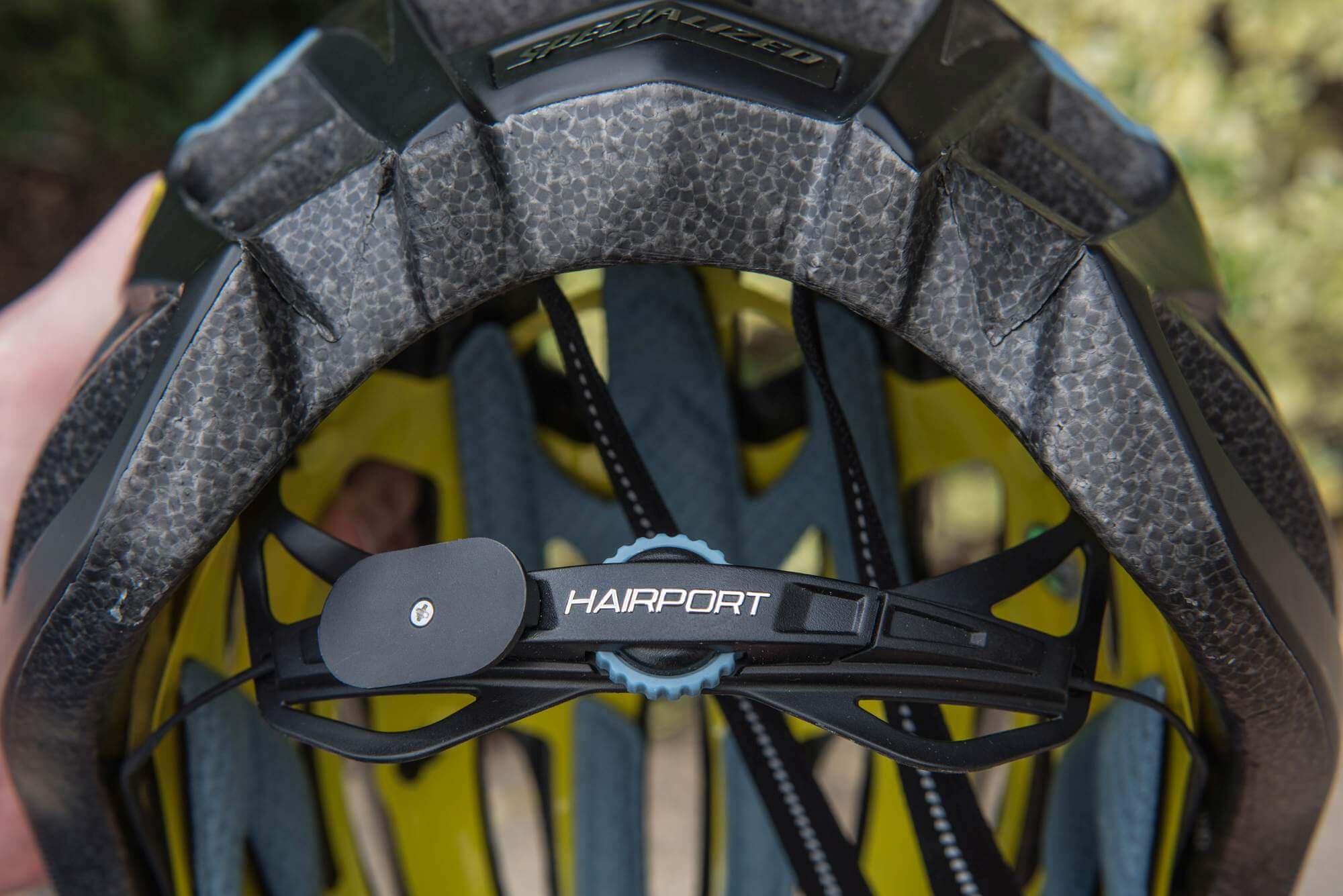
MIPS technology was recently integrated into the Echelon II, and it has the most visual example of a MIPS we’ve seen: The yellow plastic grid clearly rotates back and forth, demonstrating how the helmet will react upon impact. The excellent — and not fussy — straps are secured beneath the MIPS grid, and this position keeps them flat down the side of your face.
The heavy-nylon chin straps have an unusual configuration, which also keeps them from twisting. Each chin strap is composed of three individual straps: one connects to the front of the helmet, one to the rear of the helmet and the third smaller strap has the buckle. All three straps are attached to a triangular connector, which sits just beneath your earlobes. Since the Echelon II is the only helmet we tested with this feature, the photograph below illustrates why it’s unique.

Although the buckle lays at an odd angle just beneath the chin, it was barely noticeable when riding. The chin-strap design combined with the precise Hairport fit system made the Echelon II very secure and also comfortable to wear.
The Echelon II was updated by Specialized in 2019 with a mount (next to the Hairport dial) for the company’s ANGI crash sensor. If the ANGI sensor detects a crash, it begins a countdown, which you need to stop if you’re uninjured. However, if you are injured, the ANGI sends your contacts the GPS coordinates of the crash. Specialized sells the ANGI for $50 on its website. As of publication of this review, the Echelon II is the only helmet with the ANGI mount.
Reviewers of the previous model of the Echelon II, which didn’t have MIPS or ANGI, complained that the helmet was heavy and hot. We did not find that to be the case in our testing. It was not heavier than the other helmets we tested, and with all of the vents, our rider’s head kept cool. Specialized has clearly made improvements in the new Echelon II, and its price ($90) is very reasonable for such an advanced bike helmet.
Key takeaways:
- The Echelon II is a lightweight and well-ventilated road helmet that’s been recently updated to include the MIPS technology.
- The Hairport fit system allows precise adjustment and also accommodates a ponytail through the back of the helmet.
- Its innovative chin straps stay flat on your cheeks and jaw.
- Specialized has built in a mount for its patented ANGI crash sensor.
Best commuter helmet: Thousand
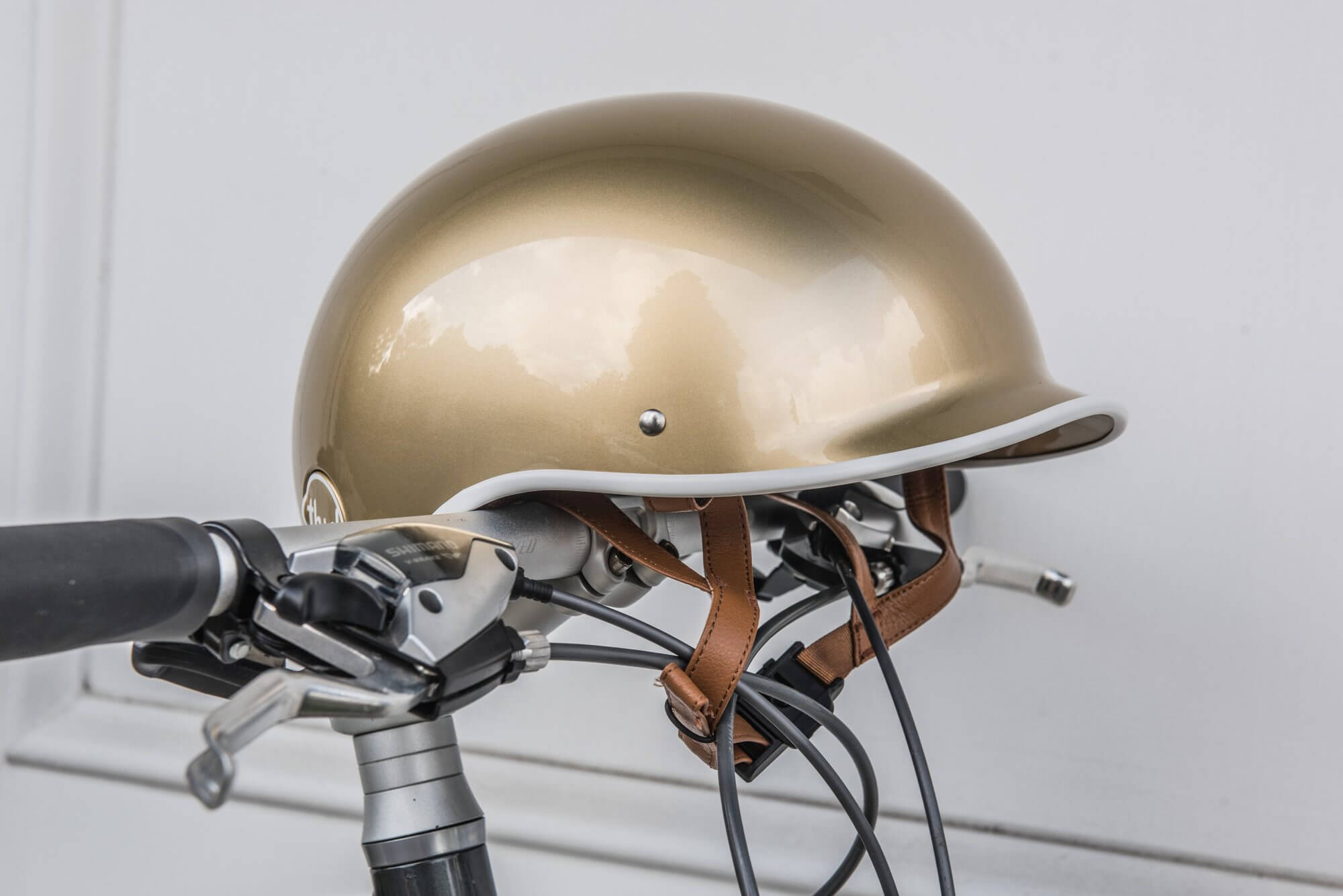
The Thousand – Anti-Theft Helmet isn’t just a uniquely stylish commuter helmet; it’s also been designed for safety and comfort. It’s one of the few commuter helmets that recently added a dial-adjustment system so it fits as securely as a road bike helmet. The Thousand sits low on the head, and with its snazzy brim, it resembles one of those helmets a 1960s Italian movie star might wear when zipping around Rome on a Vespa.
Three specific features elevate the Thousand as the best commuter helmet. First, its anti-theft device, which is backed by the company’s anti-theft guarantee. It’s a secret pop lock positioned just behind the right ear. You lift the quarter-sized magnetized disk that’s attached to a thin rubberized cord. This reveals the channel in the helmet through which a bike lock can be threaded and attached to your bike. The company backs this ingenious device with a guarantee that if your helmet is stolen, it will be replaced for free.

As a California-based company, Thousand is dedicated to reducing its carbon footprint and donates 1% of profits to For The Planet in their Carbon Offset Program. In keeping with their environmentalist goals, Thousand makes its helmets’ chin straps from “vegan leather,” a blend of microfiber and polyurethane. The straps feel and look like leather, and though we found them a little stiff at first, they became more flexible with repeated use.
The third stellar feature is the magnetic-release buckle on the chin straps. It’s slightly thicker than other strap buckles, but it can be released with one hand in seconds, and it attaches automatically by simply holding the straps together. Having struggled with other helmets’ buckles, we would love to see other manufacturers replace them with magnetic-release buckles like this.
Like other commuter helmets, ventilation is limited so you won’t get drenched in a sudden downpour. Our only negative comment about the Thousand helmet is that the vents are too narrow. They add to the overall aesthetics of the helmet, but they do little for keeping your head cool.
Amazon currently sells Thousand’s Heritage collection, but Thousand recently added a new sparkling metallic collection in rose gold and titanium. All three sizes of Thousand’s helmets are priced the same at $89. If you’re budget-conscious, this might seem expensive for a commuter helmet. But if stylish design, ease of use and environmentally friendly corporate policy are important to you, the Thousand – Anti-Theft helmet is worth your consideration.
Key takeaways:
- The Thousand – Anti-Theft commuter helmet has a unique pop-lock feature that allows you to lock the helmet to your bike.
- Its magnetic release buckle lets you attach and remove the helmet in seconds.
- In keeping with its environmentally friendly policy, the helmet’s chin straps are made of “vegan leather.”
Other helmets we tested
Bontrager – Quantum

The Bontrager – Quantum was our second-favorite road helmet, and the difference between it and the Specialized – Echelon II was small but significant: Its nylon chin straps twist and don’t lay flat on the face. Bontrager-branded products and bicycle components are solely distributed by TrekBikes, which continues to develop helmet technology for preventing brain injuries.
The Bontrager had the thickest polycarbonate shell of all the helmets we tested and wider vents, particularly in the back of the helmet, which, as expected, kept our tester’s head cool. Bontrager guarantees a replacement if it’s “impacted” within the first year of ownership, as long as it is correctly adjusted to fit your head.
We found its instructions for properly adjusting the various straps and buckles to be laborious, and after about an hour, we finally got it to fit. It was lightweight and comfortable, thanks to a generous layer of inner foam padding, and its Boa dial-adjustment system tightens the back of the helmet in precise increments.
But despite all of this preparation, its thin nylon chin straps twisted in the buckles and cut into our tester’s cheeks. The Bontrager was the most expensive helmet we tested, and despite its otherwise excellent design, the issue with the chin strap was a flaw we couldn’t overlook.
Giro – Fixture

Giro is a respected brand in the bike-helmet industry, and the Giro – Fixture has many of the same elements as the Bontrager: MIPS technology, EPS foam molded into a polycarbonate shell and good ventilation. Although it’s a one-size-fits-all helmet, it actually was a good fit on our tester’s head. We tried fitting the Giro on another person with a smaller, narrower head, and it fit snugly and comfortably on his head as well.
Its strap system lays flat against the cheeks, but we found its chin buckle finicky to unbuckle. The Giro – Fixture, however, doesn’t seem to be well made: Its outer shell is very thin, and the cheap plastic visor popped off when our tester dropped the helmet. The Giro – Fixture is expensive because of the MIPS technology; if you’re interested in the Giro line, we recommend looking at other models.
Retrospec – CM-1 Classic Commuter

The Retrospec – CM-1 Classic Commuter is an inexpensive commuter helmet that’s also a favorite with skateboarders. It has a retro eggshell shape and an array of matte color choices. The Retrospec has thin, overly long nylon straps attached to rivets inside the outer shell, and upon inspection, it appears that the EPS foam is glued — and not molded — into the shell.
The Retrospec comes in three sizes, and though it doesn’t have a fitting system, two sets of foam padding of different thicknesses are provided for securing the helmet snugly on your skull. Ventilation is fine on the top of the helmet but poor on the rear, so it was hot to wear.
Schwinn – Thrasher

The Schwinn – Thrasher is one of the most popular road bike helmets on Amazon. It has a narrow elongated shape and comes in many designs and bright colors. This helmet has three sizes — adults, teens and kids — but not all designs and colors are available in all the sizes.
We tested the adult size, which is stated to be expandable to 24.5 inches, our tester’s head size. Sizing is adjusted by removing inner padding and ratcheting the flimsy dial tightener, but even then, the Thrasher was still too tight for our tester.
The Thrasher was the least expensive of the helmets we tested, which, according to Amazon reviewers, is why they bought it. We found it to be cheaply made: it had too much exposed EPS foam and a thin, plastic shell that was beginning to peel off.
Base Camp – Urban Commuter

The Base Camp – Urban Commuter is another inexpensive and popular helmet. It’s a hybrid of a classic commuter helmet and a road bike helmet, and many Amazon reviewers love its sleek look. The EPS foam does appear to be molded with the outer shell, but the shell does not cover all of the foam in the back of the helmet, which could be easily damaged in an accident.
The Base Camp is another one-size-fits-all helmet, but it was too small and narrow for our tester’s head. It has a similar strap system as the Bontrager but includes a foam and Velcro chin support that can double as a handle. The Base Camp also has a triangular LED light positioned in the top back of the helmet, and it’s easily activated by pushing a button.
As we mentioned earlier, however, although the Base Camp has a CPSC label, it does not have the mandatory warning labels, so for safety’s sake, we cannot recommend this helmet.
The bottom line
The most important accessory for all bike riders of all ages is a helmet. It’s been scientifically proven that wearing a helmet can dramatically decrease injury to your head and brain if you’re ever thrown from your bike in an accident. The safest helmet will be the one that fits your head, so if you’re buying a helmet from a local bike shop, we recommend trying it on before purchasing it. However, if you’re buying a helmet online, make sure you take exact measurements of the circumference of your head.
Although integrated MIPS technology increases the cost of a bike helmet, it adds another measure of safety, and so we’ve selected the Specialized – Echelon II as the best road helmet. Three road helmets we tested had MIPS, but the Echelon II’s chin straps and ponytail-ready Hairport fit system made it the most secure and comfortable to wear.
Commuter helmets aren’t designed for high-speed bike riding and don’t have a sophisticated fit system: basically, tighten the chin strap and go. The stylish and innovative Thousand – Anti-Theft Helmet is our choice for the best commuter helmet because it has a road-helmet’s dial-adjustment fit system. It was the most secure and comfortable of the commuter helmets we tested, and it was, by far, the most attractive with a retro 1960s design.
More Reviews
Delta Cycle - Michelangelo
Topeak - Joe Blow Sport III
Klean Kanteen - 20-Ounce Insulated
RTIC - 30-Ounce Tumbler
The Best Filtered Water Bottles
Brita - BB10
AMES - 2519500
Masterbuilt - 20071117
Chill Pal - PVA Cooling Towel
The Best Patio Umbrellas and Stands
Treasure Garden


